Tales of Polyphony (Digital)
"Jukyu? Jukyu?"That's what the taxi cab driver is yelling at us. Well, yelling only in the technical sense. He's a very friendly guy and he's only yelling, I think, to emphasize his question to us: Are you sure you're looking for building jukyu (nineteen) in Edogawa? Yes, friendly yelling cab man,...
"Jukyu? Jukyu?"
That's what the taxi cab driver is yelling at us. Well, yelling only in the technical sense. He's a very friendly guy and he's only yelling, I think, to emphasize his question to us: Are you sure you're looking for building jukyu (nineteen) in Edogawa? Yes, friendly yelling cab man, I'm quite sure that's the building we're looking for. The problem is, building jukyu isn't showing up on his map of the area, and few, if any of the buildings in the area are clearly marked with addresses.
That was the scene earlier today as Tyler and I made our way to Polyphony Digital for a press event for Gran Turismo HD. The PD offices are in an entirely separate district of Tokyo: Edogawa ward, to be specific. The building itself, which we eventually found with the help of not one but two helpful taxi drivers (as well as a handful of passersby), is about as non-descript as you can possibly imagine, especially considering the building's second floor houses one of the most successful game developers in the history of the industry.
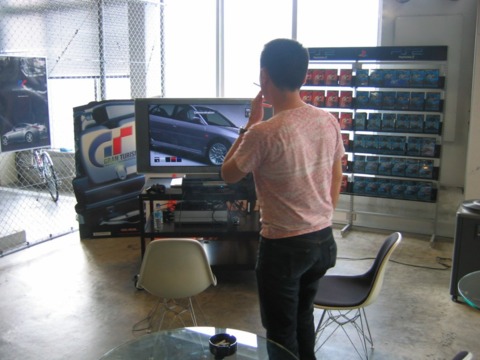
We arrived roughly 30 minutes before we were supposed to, and were lead up to the second floor via a tiny elevator which was barely big enough to hold myself, Tyler, our camera equipment, and the PD employee who let us in. Once the elevator opened, we walked into a work space that's unlike practically any development studio I've ever been in. Part industrial workspace, part car garage, and part futuristic office space, the PD HQ is at once an ode to car culture as well as a quirky and functional (if not always tidy) work space.
Our first stop before the official events began was a few laps in the Gran Turismo 4 simulator machine--essentially a suped-up version of the racing seat setups in which we sampled Gran Turismo HD for yesterday's hands-on preview. This simulator, designed and built as a joint project between PD and Subaru, features a number of hydraulics which literally lift the racing seat into the air. Once you hit the track, the struts jostle and shake with every move you make. Go up the long hill at Laguna Seca and the seat will tilt backwards; jet down through the corkscrew and the simulator will shove you forward and through the turn.
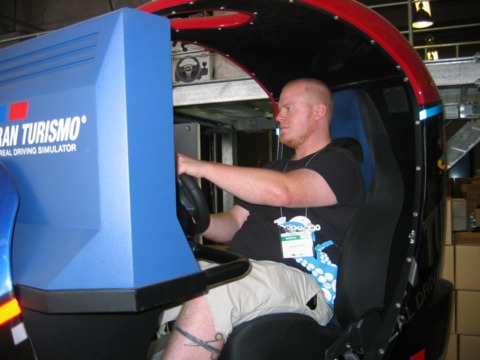
The system, which is estimated to cost around $40,000 runs four PlayStation 2 units running GT 4 code simultaneously to give you three screens of the action in front of you, as well as a spectator's view of the race on an entirely separate screen. To say the least, it's an exhilarating and entirely new way of experiencing Gran Turismo 4. We wished we had more time to turn laps in the simulator but, before we knew it, the tour of the PD studio had begun.
The overall vibe of the PD offices is one of carefully constructed chaos. Literally everywhere you look there are boxes and papers, toys, posters, magazines and automobile memorabilia, strewn about with relative abandon. But in between the mess are small pockets of peaceful organization, such as a pristine set of cabinets where the PD crew stores any and all car parts that are shipped to them from manufacturers. Another sliver of peace can be found in PD's famed "relaxation room"; a place conceived by PD president Kazunori Yamauchi as a room where his employees can let loose, burn off some energy by hitting the weights, or just simply chill out.
The two-story library on the back wall of the relaxation room features a metric ton of PS2 videogames, as well as practically any motorsports magazine you care to name. But peak up to the second level of the library and you'll see another surprise: a massive collection of coffee table books detailing the many cities which host Gran Turismo tracks--Paris, London, Rome, and so on. If you're a PD environmental artists looking for some inspiration on creating one of the notoriously detailed backgrounds of Gran Turismo HD, you need look no further than here.
As anyone familiar with game development will tell you, making games is hard work, full of long hours and little sleep. Polyphony Digital employees are covered there as well, thanks to a number of small hotel space living quarters which can be used by anyone looking to catch a few Zs without leaving the office. Of course, we should point out that we saw a few folks sleeping underneath their desks during our tour (and this was on a Saturday, no less).
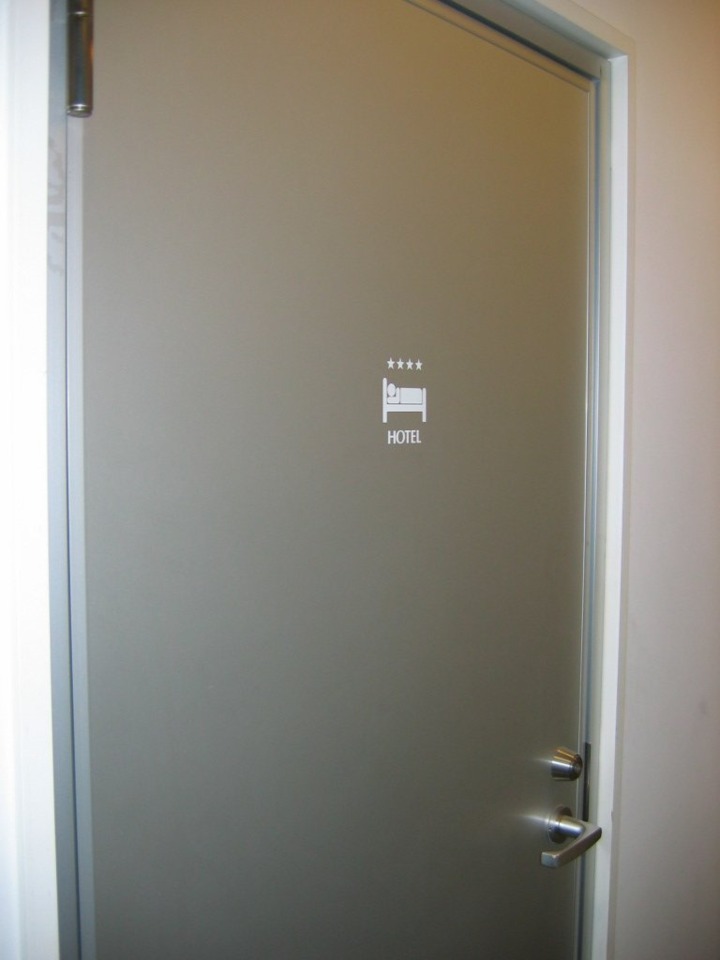
After the tour, it was time for Yamauchi to address the press; and he more or less gave the same presentation which was given during the Sony keynote on day one of TGS. If you haven't heard by now, here's the lowdown on how GT HD is going to work:
The game will essentially be split into two parts: Gran Turismo Premium and Gran Turismo Classic. The GT Premium portion of the game will feature 30 cars and two tracks (one of which is the mountainous course found in the TGS demo). Gran Turismo Classic, on the other hand, will feature approximately 770 cars, more than fifty tracks, and literally thousands of downloadable items.
So why the need for the split? The answer is time. Using the GT Premium demo as his example, Yamauchi explained that each of the ten cars found in that demo took six months to model. All the cars and tracks in GT Premium are literally being built from the ground up. The cars, tracks, and items found in GT Classic, then are essentially upgraded HD assets of the data found in previous Gran Turismo games. If, Yamauchi explained, they wanted to make a game as big in scope as GT 4 and bring them to the same standards as GT Premium's cars and tracks, it would take a minimum of three years before the game came out. Thus the need for the Gran Turismo HD as a sort of "holdover" until Gran Turismo 5 arrives, whever that may be.
During his presentation, Yamauchi was quick to point out that online will be a massive part of GT HD. Not only will things like online racing, car clubs, and leaderboards be supported, but the Polyphony Digital folks are banking on the networked side of the PS3's capabilities to providing a rich, and ever-changing list of updates, upgrades, and additions which will be created as the life of GT HD continues. Obvious examples include downloadable cars and tracks, but Yamauchi also said that regular AI updates will be supported along the way. Two artificial updates are already in the works for 2007 after the game is released.
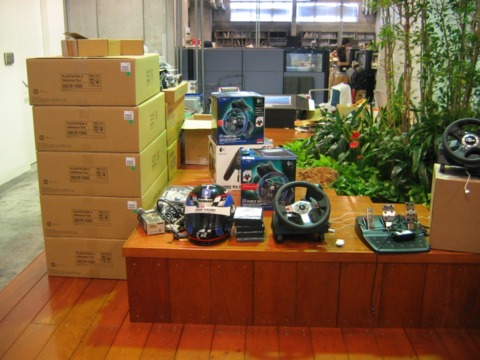
Other points of interest regarding GT HD:
- Damage, which Yamauchi jokingly referred to as "the homework (PD) always forgets to hand in" will be supported in GT HD. In some cases, race-trimmed cars might be able to incur more damage than street models; a move to appease still wary car manufacturers, who aren't necessarily keen on seeing their models cracked up in a game.
- Ferrari, a long-time holdout of the GT series will be drivable in GT HD. Yamauchi relayed the story of the head of Ferrari engineering calling the office just a few days ago to compliment the team on the modeling they did on some of their new Ferrari makes, a compliment the PD crew takes as a serious honor.
- Speaking of models, Yamauchi was quick to point out that, all cars being modeled to GT HD Premium standards will include both interior and exterior views. Could we finally see accurate interior cameras in a GT game?
- The long-delayed Gran Turismo game for PSP should be back on schedule after GT HD ships next year, according to Yamauchi. In the long-term, GT players might be able to use their PSP as a conduit of sorts to buy new items, cars, or tracks for GT HD.
- The game is currently scheduled for "winter 2006/2007" release in Japan and Asia and "2007" in North America and Europe. Subsequent major upgrades would be available every six months or so, while the more basic "marketplace" content such as new cars or tracks to download should be available more or less immediately after release.
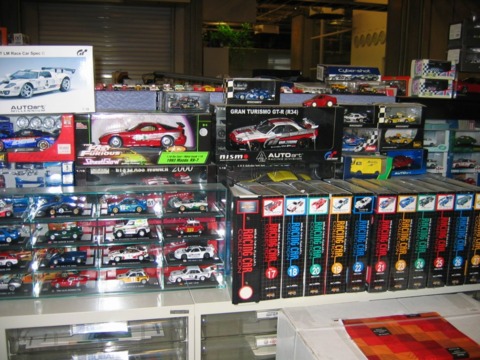
Well, I've gone on for entirely too long about this whole experience. Suffice it to say that this was one of the best days I've had since working here at GameSpot, as anyone who knows me knows that I hold Yamauchi and the entire crew at Polyphony Digital in the highest regard. I hope you enjoyed reading this little peak behind the curtain at PD and, if you're like me, it's gotten you even more excited for GT HD.
Got a news tip or want to contact us directly? Email news@gamespot.com
Join the conversation